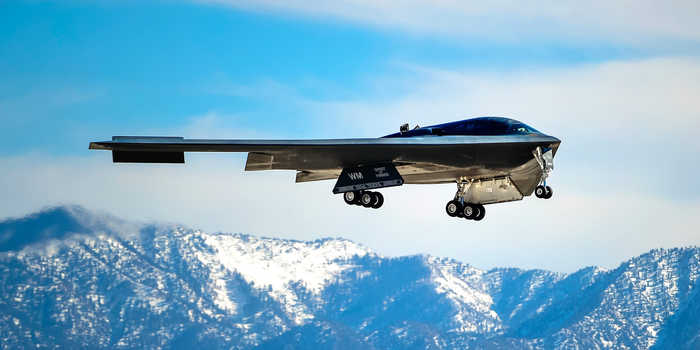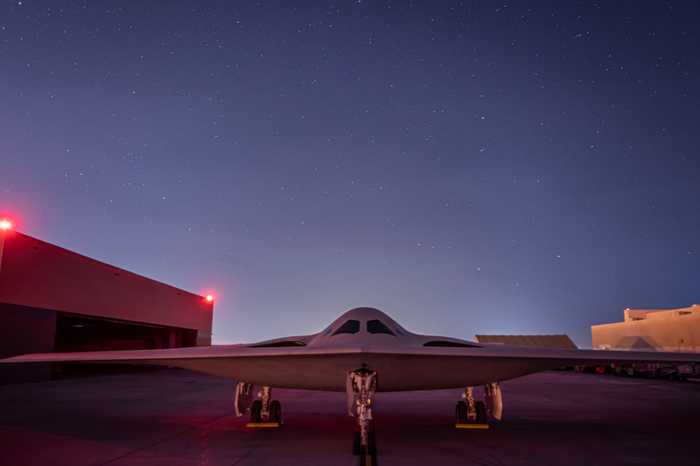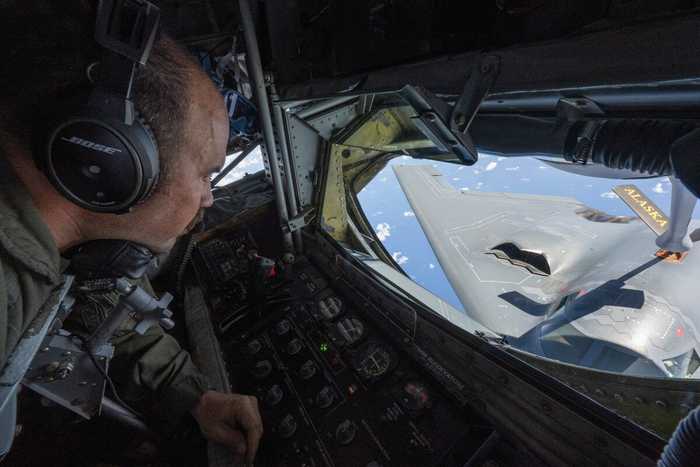Published 07:04 IST, May 25th 2024
The U.S. Air Force's unveiling of the B-21 Raider has sparked considerable interest and comparison with its predecessor, the B-2 Spirit.
Introduction
The U.S. Air Force's unveiling of the B-21 Raider has sparked considerable interest and comparison with its predecessor, the B-2 Spirit. Although both aircraft share the common goal of maintaining America's air superiority through stealth and advanced technology, their design differences, particularly in the cockpit, highlight significant advancements and strategic shifts.
The Evolution of Stealth Bomber Cockpits
When examining the cockpit windows of the B-2 and B-21, the differences are striking. A comparison image posted on social media by aviation enthusiast @thenewarea51 offers a clear view of these aircraft from similar angles and under similar lighting conditions. The B-21's cockpit glazing is notably different from the B-2's wraparound windscreen. The B-21 features angled slit windows, a stark departure from the B-2's design, which emphasizes side visibility and a broader field of view.
The design of the B-21's cockpit windows likely serves multiple purposes, with a strong emphasis on stealth. The narrow forward field of view, confined directly ahead of the aircraft, prioritizes vertical over horizontal visibility, which is essential for aerial refuelling—a critical capability for the B-21's long-range missions. This design choice suggests that low observability (stealth) took precedence over conventional visibility, especially considering the strategic importance of minimizing radar cross-section from the front and lower aspects.

B-2 Spirit
Development: The B-2 Spirit, developed by Northrop Grumman, was designed to penetrate deep into enemy territory and deliver both conventional and nuclear ordnance. It leveraged pioneering computer-aided design and manufacturing technologies to meet complex low-visibility requirements.
Design: The B-2 is a flying-wing aircraft with no fuselage or tail, contributing to its low radar cross-section. This design, reminiscent of earlier Northrop aircraft like the YB-35 and YB-49, allows for high aerodynamic efficiency and a large payload capacity. The B-2 can carry up to 40,000 lb (18,000 kg) of ordnance within its internal bomb bays.

B-21 Raider
Development: Initiated under the Long Range Strike Bomber (LRS-B) program in 2011, the B-21 Raider is being developed by Northrop Grumman following a competitive bidding process. The program emphasizes cost-effectiveness and rapid capability development, managed by the Air Force Rapid Capabilities Office.
Design: The B-21 Raider is described as a "sixth-generation" aircraft, emphasizing advanced stealth capabilities and networked sensor-shoot systems. Renderings suggest a smaller, lighter design compared to the B-2, with blended inlets and a two-wheel main landing gear. The B-21 is intended to function as an intelligence collection platform, battle manager, and interceptor in addition to its primary role as a bomber.
Advertisement
Size and Scale Comparisons
The B-21 is overall smaller than the B-2, which affects the perception of its window size and cockpit space. While the exact dimensions of the B-21 are not publicly known, it is estimated to be roughly the length of an F-15 fighter jet. This comparison highlights the B-21's compact design, especially about the B-2, which measures approximately 69 feet in length. The smaller cockpit and windows are designed to support the aircraft's stealth capabilities while accommodating the necessary avionics and pilot instrumentation.
- B-2 Spirit
Range and Endurance: The B-2 has a range of approximately 6,000 nautical miles (6,900 miles; 11,000 km) and refuels every six hours, taking on up to 50 short tons (45,000 kg) of fuel at a time.
Armaments: The B-2 can deploy a variety of munitions, including nuclear bombs (B61, B83), conventional bombs (Mark 82, Mark 84), and specialized munitions like the Massive Ordnance Penetrator (MOP) and Joint Direct Attack Munition (JDAM). Its internal bomb bays enhance stealth by reducing radar visibility.
- B-21 Raider
Range and Endurance: Specific range details for the B-21 have not been publicly disclosed, but it is expected to meet or exceed the B-2's capabilities, ensuring global reach.
Armaments: While exact armament details are classified, the B-21 will likely carry advanced munitions, including nuclear and conventional precision-guided bombs. The focus on networked capabilities suggests integration with future long-range standoff weapons.
Technological Advances and Vision Systems
The B-2's design created nearly 40 years ago, included a comprehensive set of cockpit windows to enhance situational awareness. However, the need for pilots to physically look outside the aircraft is becoming less critical with advancements in technology. Modern vision systems, computer-generated terrain avoidance, and synthetic vision displays significantly reduce the reliance on traditional windows. The B-21 likely incorporates a distributed aperture system, allowing pilots to "see through" the aircraft using helmet-mounted displays and infrared sensors, providing a comprehensive view of the surroundings without compromising stealth.

B-2 Spirit
The B-2 features a sophisticated GPS-Aided Targeting System (GATS) and APQ-181 synthetic aperture radar for precise targeting. Its low observability and high aerodynamic efficiency make it a formidable asset for penetrating heavily defended areas.

B-21 Raider
The B-21's design incorporates lessons learned from the B-2, with enhancements in stealth, avionics, and electronic warfare capabilities. Its engines, similar to those of the F-35, promise cost efficiency and reliability.
Advertisement
Cockpit and Crew Accommodations

The interior accommodations for crew members have also evolved. The B-2 includes features such as a small cot and a toilet to support long-duration missions. While specific details about the B-21's accommodations are not yet public, it is expected that Northrop Grumman has incorporated lessons learned from the B-2 to enhance crew comfort and efficiency for extended global missions. The B-21, designed as a more mature evolution of the B-2, likely includes improved features to support the crew during long flights.
The B-21's design reflects decades of experience and technological advancements since the B-2's development. The Raider's planform aligns with what the B-2 was initially intended to be before low-level penetration requirements altered its design. The B-2 was cutting-edge at its inception, often considered an experimental production aircraft with only 21 units built. In contrast, the B-21 is expected to benefit from the operational insights and technological innovations gained over the years, making it a more refined and capable successor.
The choice of cockpit glazing and other design elements underscores the priority placed on stealth and survivability. These features suggest the integration of advanced technologies that mitigate the challenges of reduced visibility, ensuring the B-21 remains a formidable asset for years to come.
The comparison between the B-2 Spirit and the B-21 Raider highlights significant advancements in stealth technology, design philosophy, and operational capabilities. While the B-2 set the standard for stealth bombers, the B-21 represents the next generation, leveraging modern technology to address contemporary threats and mission requirements. As the U.S. Air Force continues to develop and deploy the B-21, it stands as a testament to the ongoing evolution of America's airpower and strategic deterrence capabilities.
06:58 IST, May 25th 2024